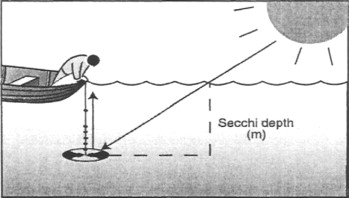Secchi depth is a water quality measurement of clarity.
An 8”-diameter black and white disk is lowered into the water (flat side parallel to the water’s surface) and the first depth at which it can’t be seen is recorded.
 It’s one of the oldest of all quantitative water quality measurements. Catholic priest Pietro Angelo Secchi demonstrated the technique to Pope Pius IX while onboard the pope’s yacht in 1865.
It’s one of the oldest of all quantitative water quality measurements. Catholic priest Pietro Angelo Secchi demonstrated the technique to Pope Pius IX while onboard the pope’s yacht in 1865.

Measurement of Secchi depth. From: Carruthers, T.J., Longstaff, B.J., Dennison, W.C., Abal, E.G. and Aioi, K., 2001. Measurement of light penetration in relation to seagrass. Global seagrass research methods, pp.370-392.
We still use this simple but elegant method today and Iowa Department of Natural Resource's (DNR) ambient water monitoring program assesses lakes for clarity in this manner.
Research shows that the public’s perception of “good” water quality corresponds to a Secchi depth of about 3 feet; in other words, a depth where you can see your toes when standing in waist deep water (1).
Iowa has a little over 100 lakes, and their degraded condition keeps DNR busy restoring them.
You can easily make the case that lake restoration is the best thing Iowa DNR does.
